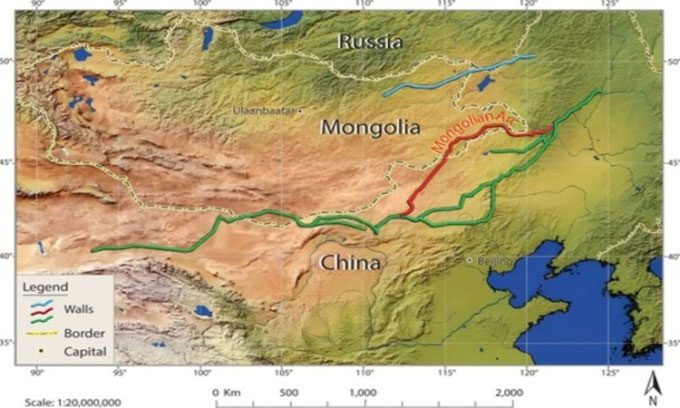Researchers have discovered a 40km long wall along the Mongolia-China border that appears to have been hastily constructed to fend off invading forces.
A section of the Great Wall of China that extends into Mongolia has been analyzed for the first time, allowing researchers to make several conjectures about the history and function of this massive structure. Stretching over 405km, this wall is nicknamed “Mongolian Arc” due to its winding path. The study of the wall was published in the journal Field Archaeology, as reported by IFL Science on December 28.

Location of the Mongolian Arc (red line). (Photo: Field Archaeology)
Running almost parallel to the border between China and Mongolia, this ancient barrier stretches from Sukhbaatar Province to Dornod Province in northeastern Mongolia, where temperatures often drop to -25 degrees Celsius. Despite its large scale and complexity, researchers are still unsure exactly when the structure was built, who constructed it, and for what purpose.
Comprising an earthen wall, a trench, and 34 structures, the wall and its construction are mentioned in several historical documents from the 11th to 13th centuries, although current researchers cannot provide a more precise dating. Noticing that the Mongolian Arc has received little attention in academic texts, the research team from the Hebrew University of Jerusalem in Israel combined satellite imagery, maps from China and the Soviet Union, along with direct field observations to analyze the wall and its accompanying structures.
The most notable finding was that the Mongolian Arc contains many large gaps, indicating that it was built hastily and thus was never fully reinforced. “A plausible interpretation for the gaps, which represent vulnerabilities in the system, is that the Mongolian Arc was constructed quickly at the end of the Jin Dynasty as a defensive layer against Mongolian invasions,” the research team stated. While researchers are uncertain about the wall’s dating, it is likely that the construction coincided with the Mongolian military campaigns against the Jin around the year 1200. However, they emphasize that this is merely a hypothesis.
Another hypothesis put forth by the research team is that the Mongolian Arc was not intended for military purposes, but rather was associated with controlling the movement of residents and livestock, possibly related to tax collection. Evidence supporting this hypothesis comes from the fact that the wall is not an effective barrier, with many lookout posts positioned poorly, providing limited visibility of the surrounding area.
Researchers plan to conduct further excavations of some structures related to the Mongolian Arc to determine the timing of its construction and the function of the wall.





















































